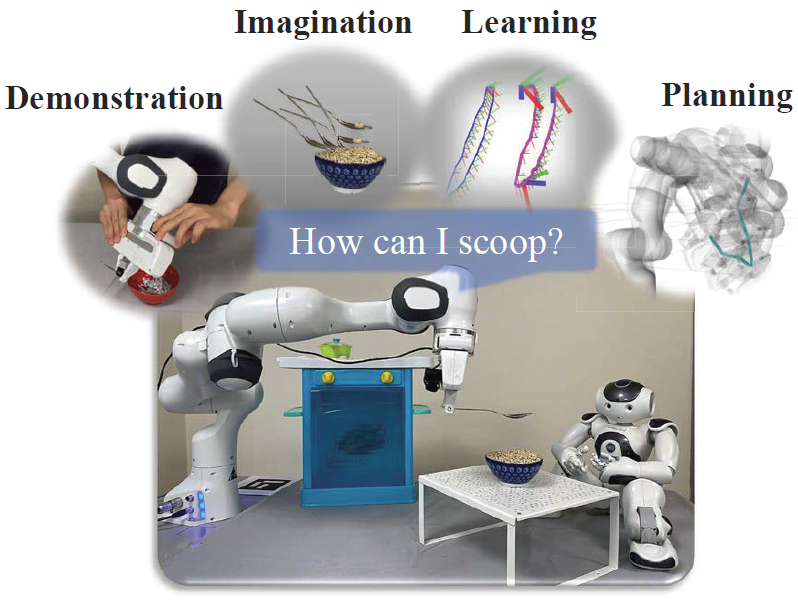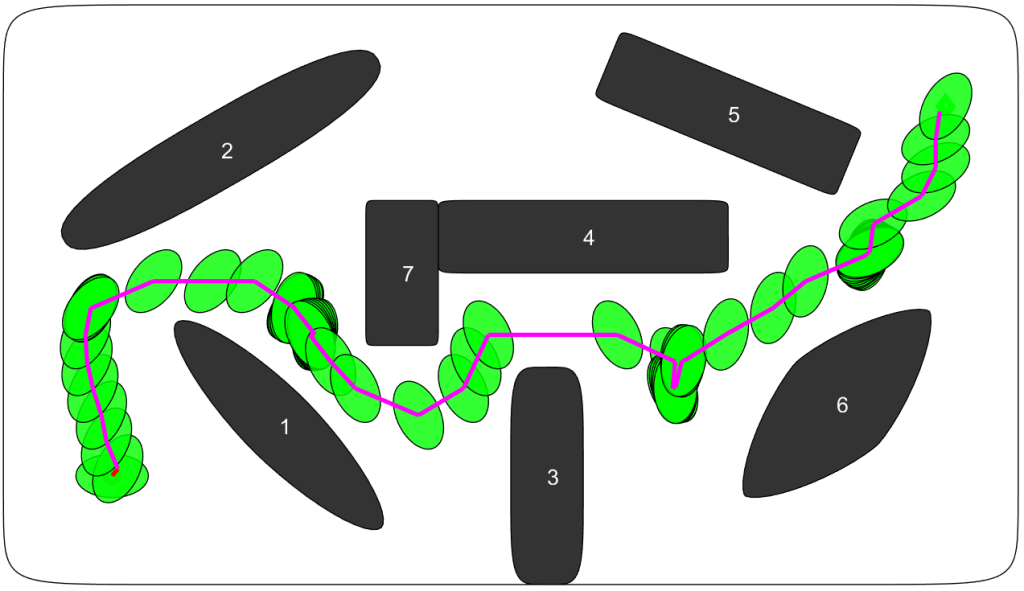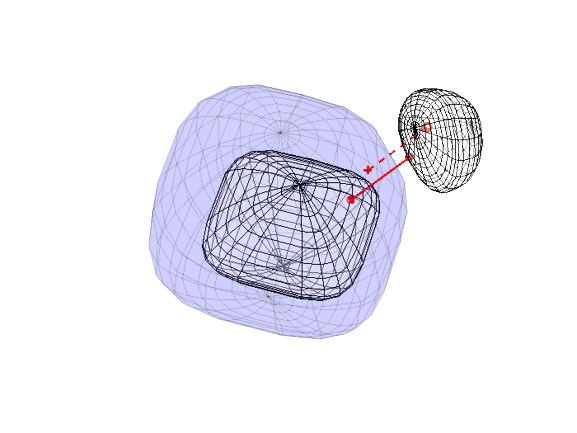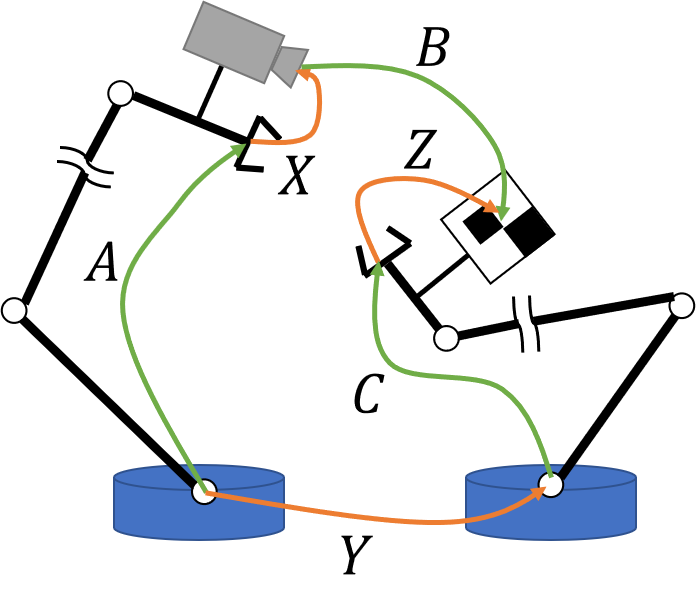阮思朴 RUAN Sipu
Research
Robot Learning from Demonstration
 This work proposes PRIMP: PRobabilistically-Informed Motion Primitives, a learning-from-demonstration (LfD) method using probability densities on the workspaces of robot manipulators. The model learns the probability distribution of the end effector trajectories in the 6D workspace. It is able to adapt to new situations such as novel via points with uncertainty. Workspace-STOMP, a new version of the existing STOMP motion planner, is also introduced, which can be used as a post-process to improve the performance of PRIMP and any other reachability-based LfD method. The combination of PRIMP and Workspace-STOMP can further help the robot avoid novel obstacles that are unseen during the demonstration process. PRIMP runs more than 5 times faster than existing state-of-the-art methods while generalizing trajectories more than twice as close to both the demonstrations and novel desired poses. The methods are demonstrated in household tasks with unseen obstacles, e.g., pouring water, scooping particles, opening and closing doors, etc.
This work proposes PRIMP: PRobabilistically-Informed Motion Primitives, a learning-from-demonstration (LfD) method using probability densities on the workspaces of robot manipulators. The model learns the probability distribution of the end effector trajectories in the 6D workspace. It is able to adapt to new situations such as novel via points with uncertainty. Workspace-STOMP, a new version of the existing STOMP motion planner, is also introduced, which can be used as a post-process to improve the performance of PRIMP and any other reachability-based LfD method. The combination of PRIMP and Workspace-STOMP can further help the robot avoid novel obstacles that are unseen during the demonstration process. PRIMP runs more than 5 times faster than existing state-of-the-art methods while generalizing trajectories more than twice as close to both the demonstrations and novel desired poses. The methods are demonstrated in household tasks with unseen obstacles, e.g., pouring water, scooping particles, opening and closing doors, etc.
Related publication
- Ruan, S., Liu, W., Wang, X., Meng, X. and Chirikjian, G.S., 2024. PRIMP: PRobabilistically-Informed Motion Primitives for Efficient Affordance Learning from Demonstration. IEEE Transactions on Robotics. doi: 10.1109/TRO.2024.3390052. T-RO, Webpage, MATLAB Code, Python Code
Robot Motion Planning
 This project studies a geometric motion planning paradigm for robots in narrow passage and with high degrees of freedom. The mathematical foundation is based on a closed-form characterization of collision-free configuration-space boundary. The solutions start with a 2D single-body robot, and extend to 3D articulated bodies. A rigorous benchmark with vanilla sampling-based motion planners shows the efficiency and effectiveness of the proposed algorithms. See more details here.
This project studies a geometric motion planning paradigm for robots in narrow passage and with high degrees of freedom. The mathematical foundation is based on a closed-form characterization of collision-free configuration-space boundary. The solutions start with a 2D single-body robot, and extend to 3D articulated bodies. A rigorous benchmark with vanilla sampling-based motion planners shows the efficiency and effectiveness of the proposed algorithms. See more details here.
Related publication
- Ruan, S., Poblete, K.L., Wu, H., Ma, Q. and Chirikjian, G.S., 2022. Efficient Path Planning in Narrow Passages for Robots with Ellipsoidal Components. IEEE Transactions on Robotics (Early Access). T-RO, Webpage, C++ Code
- Ruan S., Ma Q., Poblete K.L., Yan Y., Chirikjian G.S., 2018. Path Planning for Ellipsoidal Robots and General Obstacles via Closed-form Minkowski Operations. In International Workshop on the Algorithmic Foundations of Robotics (pp. 3-18). Springer, Cham. PDF, Slides
Collision Detection
 This project investigates collision detection between two bodies based on closed-form contact space parameterization. It starts from two ellipsoids, then generalized to two convex bodies with smooth boundaries. Using nonlinear optimization techniques, the distance between the contact space and the center of one body are computed. Then, the proximity distance or penetration depth can be derived. The proposed framework is able to deal with: (1) the static case where the contact status, separation distance or penetration depth and the corresponding witness points are resulted; and (2) the continuous case where the first time-of-impact or the minimum separation distance are computed.
This project investigates collision detection between two bodies based on closed-form contact space parameterization. It starts from two ellipsoids, then generalized to two convex bodies with smooth boundaries. Using nonlinear optimization techniques, the distance between the contact space and the center of one body are computed. Then, the proximity distance or penetration depth can be derived. The proposed framework is able to deal with: (1) the static case where the contact status, separation distance or penetration depth and the corresponding witness points are resulted; and (2) the continuous case where the first time-of-impact or the minimum separation distance are computed.
Related publication
- Ruan, S., Wang, X. and Chirikjian, G.S., 2022. Collision Detection for Unions of Convex Bodies with Smooth Boundaries using Closed-form Contact Space Parameterization. IEEE Robotics and Automation Letters, 7(4), pp.9485-9492. RA-L, Webpage, C++ Code, ROS Package, MATLAB Code
- Ruan, S.,Poblete, K.L., Li, Y., Lin, Q., Ma, Q. and Chirikjian, G.S., 2019, May. Efficient Exact Collision Detection between Ellipsoids and Superquadrics via Closed-form Minkowski Sums. In 2019 International Conference on Robotics and Automation (ICRA) (pp. 1765-1771). IEEE. PDF
Sensor Calibration
 This is an external sensor calibration problem for a multi-robot system. Mathematically it is formulated as AXB=YCZ, and viewed as a probabilistic problem by treating dirac delta functions on these rigid transformations. Then it becomes a convolution of three probability density functions based on the data acquisitions.
This is an external sensor calibration problem for a multi-robot system. Mathematically it is formulated as AXB=YCZ, and viewed as a probabilistic problem by treating dirac delta functions on these rigid transformations. Then it becomes a convolution of three probability density functions based on the data acquisitions.
My contributions were the implementation of an iterative algorithm that solves for unknowns X, Y and Z simultaneously from the mean and covariance expressions. Also, I conducted physical experiments using two NAO humanoid robots.
Related publication
- Ma Q., Goh Z., Ruan S. and Chirikjian G.S., 2018. Probabilistic approaches to the AXB=YCZ calibration problem in multi-robot systems. Autonomous Robots, 42(7), 1497-1520. PDF Code
Quantization of Euclidean Motions
Quantization is to study of a signals-to-symbol problem. The objective is to develop a alphabet containing some basic motion primitives, using which a continuous trajectory of Euclidean motions can be represented by a discrete sequence of primitives.
I mainly contributed to evaluate the efficiency and effectiveness of the proposed discretization and a coarse-to-fine decoding algorithm. I also proposed and implemented a hybrid nearest neighbor searching algorithm from an arbitrary set of Euclidean motions using the motion alphabet.
Related publication
- Wuelker, C., Ruan, S. and Chirikjian, G. S., 2019. Quantizing Euclidean motions via double-coset decomposition. Research, 2019, 1608396. PDF Code
Computational Kinematics
I have also worked on several projects related to computational kinematics. For example, I am interested in parameterizing rotations and the study of restricted motions for one body being fully contained by another. I have also involved in developing a new and useful group that describes the changes of robot poses.
Related publication
- Ruan, S., Ding, J., Ma, Q. and Chirikjian, G.S., 2019. The Kinematics of Containment for N-Dimensional Ellipsoids. Journal of Mechanisms and Robotics, 11(4), p.041005. doi:10.1115/1.4043458. PDF Code
- Chirikjian G.S., Mahony R., Ruan S. and Trumpf J., 2018. Pose Changes From a Different Point of View. Journal of Mechanisms and Robotics, 10(2), p.021008. doi:10.1115/1.4039121. PDF Code Slides
- Ruan S., Kim J.S. and Chirikjian G.S., 2016, December. Symmetrical rigid body parameterizations for humanoid robots. In 2016 IEEE International Conference on Robotics and Biomimetics (ROBIO) (pp. 1655-1661). IEEE. PDF Slides